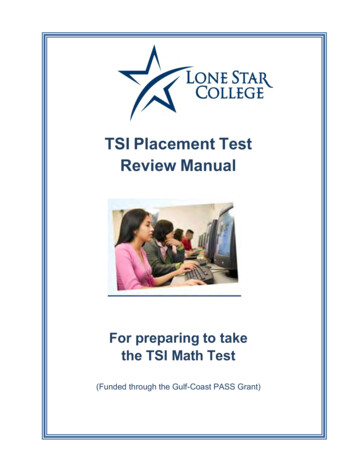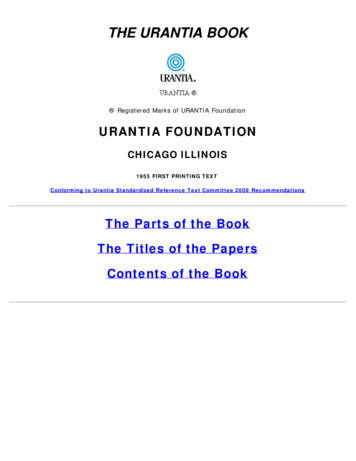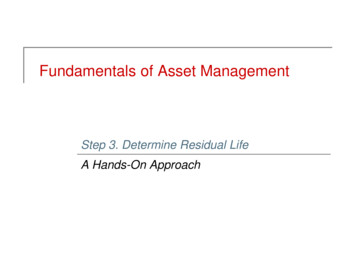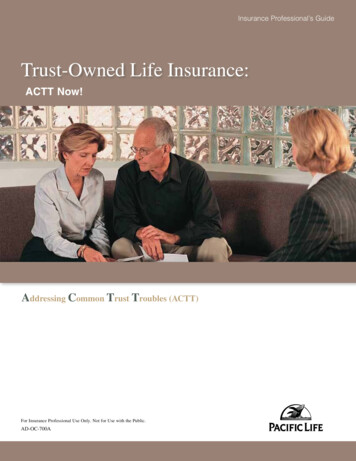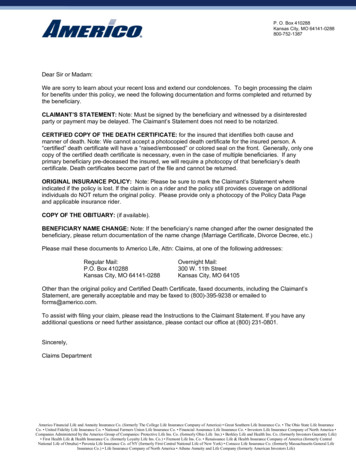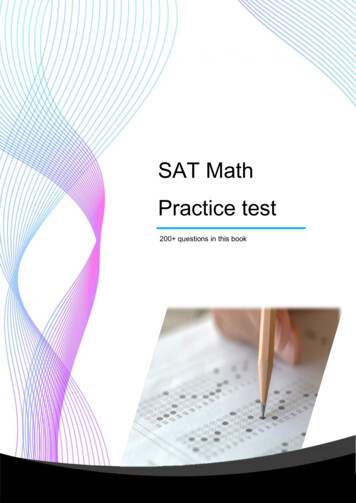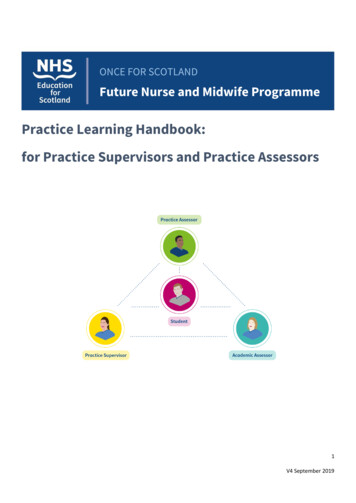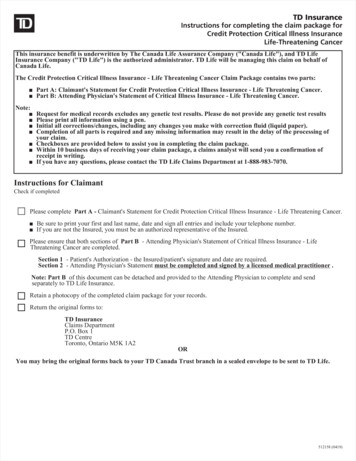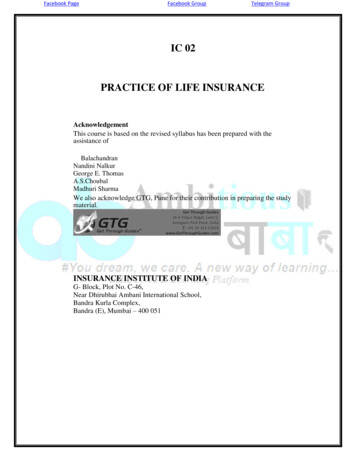
Transcription
Facebook PageFacebook GroupTelegram GroupIC 02PRACTICE OF LIFE INSURANCEAcknowledgementThis course is based on the revised syllabus has been prepared with theassistance ofBalachandranNandini NalkurGeorge E. ThomasA.S.ChoubalMadhuri SharmaWe also acknowledge GTG, Pune for their contribution in preparing the studymaterial.INSURANCE INSTITUTE OF INDIAG- Block, Plot No. C-46,Near Dhirubhai Ambani International School,Bandra Kurla Complex,Bandra (E), Mumbai – 400 051
Facebook PageFacebook GroupTelegram GroupPRACTICE OF LIFE INSURANCEIC–02Revised Edition – 2011All Rights ReservedThis course is the copyright of the Insurance Institute of India. In nocircumstances may any part of the course be reproduced.The course is purely meant for the purpose of study of the subject by studentsappearing for the examinations of Insurance Institute of India and is based onprevailing best industry practices. It is not intended to give interpretations orsolutions in case of disputes or matters involving legal arguments.Published by Sharad Srivastva, Secretary – General, Insurance Institute ofIndia. Plot No. C- 46, C- Block, Bandra – Kurla Complex, Mumbai – 400051and printed by
Facebook PageFacebook GroupTelegram GroupPREFACEThere has been a steady increase in the awareness of life insurance over thelast few years. It is extremely important that life insurance is given toppriority and not seen as an instrument of investment alone but an importanttool for building protection for the family. Experience shows that due to theinherent lack of knowledge of life insurance and its features, it has often beendismissed from being discussed and its importance undermined.In an attempt to spread knowledge and awareness of life insurance early on,this book on Practice of Life Insurance has been revised and which webelieve, would come in very handy to those associated in various fields in lifeinsurance. It has been written specifically for the benefit of students appearingfor the Licentiate examination .The topics are covered in a lucid style toprovide a framework for understanding the concepts of practice of lifeassurance, in a simplified manner and to make the learning experience, anenjoyable one. In order to make the subject easy to assimilate, this book alsouses realistic examples, diagrams, tables and case-studies to help students geta better and complete understanding on each of the topics therein.This book aims at giving a clear emphasis on the key points in the field of lifeinsurance, and to facilitate learning and ensuring a thorough understanding ofthe subject and is based on rigorous and current research.
Facebook PageFacebook GroupTelegram GroupCONTENTSCHAPTERTITLENO.PAGE NO.CHAPTER 1Practice of Life Insurance1CHAPTER 2Premiums and Bonuses23CHAPTER 3Plans of Life Insurance47CHAPTER 4Annuities82CHAPTER 5Group Insurance95CHAPTER 6Linked Life Insurance Policies120CHAPTER 7Applications and Acceptance142CHAPTER 8Policy Documents165CHAPTER 9Premium Payment, Policy Lapse andRevival181CHAPTER 10Assignment, Nomination and Surrender ofPolicy211CHAPTER 11Policy Claims227ANNEXURE 1252ANNEXURE 2256ANNEXURE 3261
Facebook PageFacebook GroupTelegram Group1CHAPTER 1LIFE INSURANCE ORGANISATIONChapter IntroductionThis chapter discusses how life insurance evolved; its organisational structure andfunctions. You will also learn about the appointment of life insurance agents, theirduties and their remuneration. The chapter also takes you through the corridors ofinsurance history and acquaints you with the fascinating growth of this industry inIndia.Overview of the Indian insurance market.Discuss about the activities and organisational structure of a life insurancecompanyLearn about the appointment of life insurance agents and their functions.Know about the remuneration to agents and continuation of agency.Discuss the trends in life insurance distribution channel.
Facebook PageFacebook GroupTelegram Group21. Overview of the Indian insurance market.[Learning Outcome a]Life insurance is commonly referred to as life assurance.Section 2(11) of the Insurance Act, 1938 defines life insurance business as follows:“Life Insurance Business” is the business of effecting contracts of insurance uponhuman life, including any contract whereby the payment of money is assured ondeath (except death by accident only) or the happening of any contingency dependanton human life and any contract which is subject to the payment of premiums for aterm dependant on human life.1.1 Growth of Insurance business in IndiaThe growth of insurance business in India started with the enactment of theInsurance Act, 1938.Postal Life Insurance (PLI)The PLI came into being on 1st February 1884, exclusively for the benefit of theemployees of the postal department. It was extended to the employees of thetelegraph department in 1988. After independence, the scheme was extended to coverthe employees of the Central and State governments, local bodies, municipalities, theReserve Bank of India, nationalised banks, public sector undertakings, port trusts,universities and government aided educational institutions, councils of scientific andindustrial research, railways and defence services. The scheme was made available tothe general public in rural areas with effect from 24 March 1995 and was calledRural PLI.Life Insurance Corporation of India (LIC)In 1956, the life insurance business in India was nationalised and the Life InsuranceCorporation of India (LIC) was formed on 1st September 1956. The entire lifeinsurance business, which was in the hands of Indian companies, branches of foreigncompanies and some provident societies were transferred to LIC.The Postal Life Insurance (PLI) and the insurance departments of some States werenot merged with the LIC.
Facebook PageFacebook GroupTelegram Group3Further ChangesUntil 1999, LIC had the exclusive right over life insurance business in India. In1999, relevant laws were amended and the life insurance sector was opened up forbusiness to private players.In 2010, there are 23 life insurance companies transacting life insurance business inIndia1.2 Liberalisation of the Indian insurance sectorInsurance in India is governed by the Insurance Act, 1938 as amended from time totime. It lays down the rules and regulations for the insurance industry. The InsuranceRegulatory and Development Authority (IRDA) Act was enacted in 1999. IRDA isthe regulator for insurance business in India.In the year 2000, the insurance sector was liberalised and opened up forbusiness to the private sector. Foreign Direct Investment (FDI) was allowed ininsurance up to 26%, wherein the foreign players were allowed to enter intojoint ventures with domestic players.Lot of domestic players joined hands with foreign partners who brought invaluable expertise and capital.Opening up of the insurance sector has led to emergence of innovative insuranceproducts and has also helped in deeper penetration of insurance.Liberalisation brought in the much needed competition and better customerservice.
Facebook PageFacebook GroupTelegram Group41.3 List of private life insurance companies operating in IndiaThe following are the existing life insurance companies (other than LIC) that arecurrently operating in India:Bajaj Allianz Life Insurance Co. Ltd.Birla Sun Life Insurance Co. LtdHDFC Life Insurance Co. LtdICICI Prudential Life Insurance Co. LtdING Vysya Life Insurance Co. LtdMax New York Life insurance Co LtdMet Life India Insurance Co LtdKotak Mahindra Old Mutual Life Insurance Co. LtdSBI Life Insurance Co. LtdTata AIG Life Insurance Co. LtdReliance Life Insurance Co. LtdAviva Life Insurance Co LtdSahara India Life Insurance Co. Ltd’Shriram Life Insurance Co. LtdBharti AXA Life Insurance Co. LtdFuture Generali Life Insurance Co LtdIDBI Federal Life insurance Co. Ltd.Canara H.S.B.C. Oriental Bank of Commerce Life Insurance Co. ltd.AEGON Religare Life Insurance Co. Ltd.D.L.F. Pramerica Life insurance Co. Ltd.Star Union Dai-ichi Life Insurance Co.LtdIndia First Life Insurance Co. Ltd.Learn about the activities and organisational structure of alife insurance company.[Learning Outcome b]The two primary objectives of life insurance companies are:To spread life insurance widely with a view to reaching all insurable persons inthe country and providing them adequate financial cover against death, at areasonable cost.
Facebook PageFacebook GroupTelegram Group5In order to clear the road blocks in the expansion of insurance coverage among lowincome segments, the IRDA has issued Micro-Insurance Regulations 2005. The aimof these regulations is to spread life insurance widely among the poor and the lowersegment people in the country.To maximize mobilisation of people’s savings by making insurance-linkedsavings adequately attractive.Rajiv has taken a life insurance policy of Rs. 12 lakhs for 20 years at a premium ofRs. 50,000 per year. He can easily save Rs. 50,000 each year to pay as premium andget Rs. 12 lakhs after 20 years or his heirs can get the money after his death duringthe term of policy. It is certainly easier for him to save a small amount every year andget a lump sum at the end of 20 years, than saving Rs. 12 lakhs himself. Hence, lifeinsurance helps to mobilise his savings so that he can get the maximum amount at alater date.2.1 Activities of the life insurance companyThe essential activities of a life insurance company are:a) Obtaining applications or proposals from prospective buyersArun is a government officer. He is going to retire after 10 years. The greatest risk hefaces after retirement is the lack of income or reduced earning capacity. MNO LifeInsurance Company approached Arun with different insurance plans. Arun appliedfor Annuity (Pension) Plan and chose the option of getting pension during hislifetime. Arun filled up the proposal form and furnished all material informationrequired by MNO Company.Examining and making decisions on the proposals for insurance is calledunderwriting. Underwriting means analysing selection and classifying of risk byassessing the economic, physical, medical and social status of a person whileaccepting the risk for their life.
Facebook PageFacebook GroupTelegram Group6Vishal was appointed as the underwriting officer of MNO Life Insurance Co. Ltd.His duty was to give the proposal a detailed consideration from all angles and decidewhether the risk is to be accepted at the standard rate or a higher rate of premium andthe overall terms of acceptance of risk depending upon the risk involved.Issuing the insurance policy document, incorporating the terms and conditionsof the insurance cover (insurance policy is a document that serves as an evidenceof the insurance contract between the insurance company and the policy-holder.It conveys the details of the risk coverage of the company).In Arun’s example above, MNO Insurance Company assessed and reviewed Arun’seconomic, physical and medical and social status. After being satisfied, the companyissued the policy document that set out the terms and conditions of the contract.Keeping sight of conditions of the insurance contract by either party e.g. timelypayment of premium by the policy-holder and timely payment of benefits as perthe policy conditions by the insurance company.Continuing with the same example, MNO Insurance Company kept sight of the termsof the contract and made timely survival benefit payment to Arun in return for thetimely payment of premium made by him.Attending to various requirements such as nominations, assignments, surrenders,payment of claims, alteration of terms and conditions during the term of policy.Neeraj is married to Kalyani and has two kids. He holds an insurance policy. Henominated his wife in his insurance policy. This is essential to avoid any disputeover the claim of insurance policy money after his death. By nominating his wife, hemade it clear that he wanted his wife to get the insurance policy moneys in case ofhis death.
Facebook PageFacebook GroupTelegram Group7Other important activities such as compliance with laws and regulations investmentof funds, maintenance of accounts, management of personnel etc.The Head Office of LIC is responsible for looking after extraordinary activities suchas judicious option of investment of funds, maintenance of accounts etc.2.2 Organisational structure of the Life Insurance Corporation of India (LIC)Meaning of Organisation and organisinga) OrganisationAn organisation is a legal entity which is created for some activity or to achieve somepurpose.It is the foundation upon which the whole structure of management is built.In other words, it is a structure controlled by a group of individuals who are workingtowards a common goal.A company is the most common form of organisation as it is owned by a group ofshareholders, who have contributed to the capital of the company. These shareholdershave come together for the purpose of achieving maximum profit. The total capital isdivided into small units called shares which are paid for by the shareholders.An organisation is called a legal entity as it is lawfully authorised to enter intocontracts, sue and be sued in courts. An organisation has a separate status andidentity, and is considered to be a person in the eyes of the law. As a person, it cancollect wealth and do business. Like a person, it can think, grow and occupy space.An organisation’s learning is the learning of its employees. When this learning isrecorded in the files of the organisation, and becomes available to the otheremployees, the organisation is said to have learnt.
Facebook PageFacebook GroupTelegram Group8There are various forms of organisation. Companies, partnership firms,proprietorship concerns, cooperative societies and trusts are the forms oforganisations that are registered under special laws. Life Insurance Corporation ofIndia is an organization created by a special Act, namely the Insurance Act.b) OrganisingThe word ‘organising’ refers to the arrangements made to enable the organisation tocarry out its activities, which are necessary in the course of business. The mainpurpose behind organising is to ensure smooth functioning of the activities of anorganisation. Organising is to set up different levels of offices or departments andsections, with distinct levels of responsibilities for supervision and to staff them withpeople having competence and authority to carry out the responsibilities.The different activities carried out in a house would be cooking, sleeping, bathingand cleaning. There are separate rooms for each of these activities. There are separateequipments in the rooms for the performance of these tasks. This is how a house isorganised for it to function smoothly.In the same way, in an organisation, decisions are made as to what activities have tobe done, where and how. The way these activities are grouped leads to formation ofoffices, departments and sections. People have to be earmarked to do these activities.Responsibilities for results have to be assigned and the authority to take decisions hasto be defined. When all these are clarified, there will be people occupying places inoffices with clear authority and responsibility. An organisation is then said to be inorder.The ‘structure’ of an organisation refers to this arrangement of departments andsections and the authorities and responsibilities vested in the various positions. Thestructure helps in stabilising processes and avoiding wasteful conflicts.Organisational structure of the Life Insurance Corporation of IndiaThe Life Insurance Corporation of India transacts business throughout India with afour tier structure. The chart below shows the organisational structure of the LifeInsurance Corporation of India.
Facebook PageFacebook GroupTelegram Group9Diagram 1: Organisation of LIC of IndiaThe following departments are likely to exist in an insurance office. These may belocated in the branch office or in the Divisional / Head Offices and are determined bythe activities they carry out, though they may be called by different names:Business development or Agency or Marketing, concerned with thedevelopment of agency force, market development and business growthNew business concerned with receiving, scrutinising and taking underwritingdecisions on new proposals and also issuing policiesPolicyholders’ servicing which would be concerned with administration of thepolicy, monitoring premium payments, lapses and revivals, attending toalterations, nominations, assignments, surrenders, loans and claimsAccounts - that handles the financial aspectsThe following departments are likely to be centralised in the Head Offices, as theyrequire specialised skill and impact the whole organisation.Actuarial, studying the claims experience, doing valuations, declaring bonuses,monitoring the adequacy of premiums, developing new products, settlingunderwriting standards, studying mortality rates, etc.
Facebook PageFacebook GroupTelegram Group10Shirin was appointed as actuary in the Head Office of LIC in Mumbai. Her duty wasto compile and analyse statistics in order to calculate insurance risks and premium.Investment of funds, studying and using the opportunities for maximisingreturnsPlanning, including marketing strategies and net distribution channelsLegal, including compliances with IRDA requirementsAdvertisement, publicity and public relationsDepartments such as personnel, HRD, training, purchases, administration for officeupkeep etc. will be found in all offices.Almost 90% of the activities relating to policyholders, from receipt of proposal tosettlement of claims are handled at the branch offices in the Life InsuranceCorporation. The other offices have supervisory and advisory functions.2.3 Organisational structure of Postal Life InsuranceThe person is the head of the Directorate and functionsChief GeneralManagerDistrict Postal Headunder the supervision and control of the Postal Servicesboard. The Postal Services Board is constituted by theCentral Government to look after the activities of the Postand telegraphs department.The person looks after all PLI operations in the district,including sales and payment of claims.OfficerPremiums are collected by all post offices but final accounting is centralised at theoffice of the Director of Accounts in Calcutta.2.4 Organisation Structure of Private Life Insurance CompaniesThe 23 private life insurance companies have started operations on various datesbetween 2001 and 2009. All of them operate only in India. In the initial stages, mostof them started with a two – tier structure: head office and branch offices reportingto head office. As the business expanded, many of them have increased not only thenumber of offices, but also the tiers. Many of them have zonal and regional officesbetween the Head Office or Corporate Office and the branches. This has becomenecessary as the new companies have been expanding their network, opening morebranch offices.
Facebook PageFacebook GroupTelegram Group11Question 1Which office of the LIC handles actuarial and investment functions?Central OfficeZonal OfficeDivisional OfficeBranch OfficeLearn about the appointment of life insurance agents andtheir functions.[Learning Outcome c]3.1 IntroductionLife Insurance in India today, is sold in more than one ways viz: AgentsTelemarketing, Internet sales, Brokers, Corporate agents etc. For some years now,there has been a rise in insurance telemarketing. Numerous insurance companies areengaged in providing insurance. They are very well trained in the art of ethicalselling and customer service.In simple language, an agent is one who acts on behalf of another. The person onwhose behalf the agent acts is called the principal.The lawyer is the agent of the client, when they argue a case in court.An ambassador is an agent of their country.The persons who do the job of meeting, explaining and persuading potentialcustomers are called insurance agents. They are the salesmen or intermediariesbetween the insurer and the public. Agents have to be licensed from the IRDA underthe Insurance Act. A licensed agent can work with only one life insurer of theirchoice. Agents may be individuals or corporate bodies.
Facebook PageFacebook GroupTelegram Group12There is also a system of insurance brokers. They are independent and not attachedwith any particular insurer. A broker usually does business with more than oneinsurance company. An insurance broker is someone who represents more than oneinsurance company, unlike an insurance agent who represents only one insurancecompany. A broker is a mediator between the customer and the insurancecompanies, charging commission only from the insurer.Ram is a life insurance agent with XYZ Life Insurance Company. He met his client,Mrs Roy, and offered her various policies of XYZ Company, to suit her needs. MrsRoy bought the endowment plan for 20 years from Ram. Later, she got her addresschanged through Ram on her policy records, as she had moved to a new home. Thisis how an agent brings in new business and provides services throughout the term.Ajay, an insurance broker, offered his client, Mr Shaikh, term insurance policies of10 different companies to choose the most suitable one. Mr Shaikh bought a 25 lakhsterm plan of AAA Life Insurance Company. Ajay would get his commission fromCompany. He would also be able to provide service for Mr Shaikh’s policywith AAA Company as and when needed.In this chapter, the word ‘agent’ is used to refer to all salesmen, whether called anagent, corporate agent, bank, broker, insurance advisor, consultant or by any othername.3.2 Need of an agent in insurance sellingAgents are essential for selling life insurance due to the following reasons:Insurance is a concept that needs to be explained face to face.Personalised guidance can be given only when there is personal interactionbetween the agent and the customer.The agent gets to meet the proposer personally. Therefore, the agent is in aposition to provide valuable information such as details on personal styles,habits, family etc. which is important for risk evaluation and also helps tounderstand the special needs of the prospective customer.The agent can explain to the customer how insurance is not just anotherinvestment avenue, but provides timely financial security as well.Each prospective buyer has special needs and requires specialised solutions.Personalised guidance can be given only when there is a live interaction with theagent.
Facebook PageFacebook GroupTelegram Group13Atul wishes to buy a life insurance policy. He doesn’t know whom to approach. Helogs on to the website of an insurance company, but still cannot understand whichproduct (policy) would be suitable for him. So, he goes to his friend for help. Hisfriend sends an insurance agent, Lalit to him. Lalit tells Atul about the differentinsurance products available, along with a recommendation of which one would begood for him and also clears all his doubts. This is how Lalit, an insurance agent, actsas an intermediary between Atul, the proposer and the insurer.The Life Insurance Corporation of India has more than 13 lakh agents on its rolls.Some of them are full time while some work part time. The other companies are alsosteadily adding to their agent base. The Postal Life Insurance appoints unemployedyouth and extra departmental branch postmasters to procure business under the RuralPLI. Retired employees of the Posts and Telegraphs department and of the Railwaysare employed as Field Officers, on commission basis to get business.3.3 Appointment of agentsDiagram 2: To be appointed as an agent, one should fulfil the followingconditions:
Facebook PageFacebook GroupTelegram Group14Deepak aspires to be an insurance agent. He is 20 years old, intelligent and an honestman. He approaches the Development Officer of the LIC. It is the duty of theDevelopment Officer to recruit and train suitable persons as agents. TheDevelopment Officer finds Deepak suitable to become an insurance agent because:He is not a minor.He is not a person of unsound mind.He is not guilty of any criminal breach of trust.He fulfils all the criteria mentioned in the diagram above.However, the Development Officer tells Deepak that he needs to undergo practicaltraining for at least 50 hours from an institution approved by the IRDA and also passthe pre-recruitment exams conducted by any examination body recognised by theIRDA.The prospective candidates would have to give their particulars in a format called theapplication form and subject themselves to a written test, prescribed by the IRDAand also a personal interview. The prospective candidates can be found through:press advertisementsreference from other agents, staff, clientsvisit to college campusesemployment agenciesmembers of staffIt is not just individuals who can become agents. Companies, firms, banks,cooperative societies etc. can also become agents. These will have to designate oneor more persons as ‘Corporate Insurance Executives’, who will be required to obtainlicences like individual agents. Other members or employees of the organisation canalso work for the corporate agent and they are called ‘specified persons’. They alsoneed to obtain certificates.In LIC, there are supervisory level employees between the agent and the branchoffice. They are called Development Officers. They are regular salaried employeesand their duty is to recruit and train suitable persons as agents. These intermediariescan also be called Agency Supervisors, Agency Managers etc.Besides agents appointed by Development Officers, there are Direct Agents andCareer Agents. Direct Agents are senior experienced agents, who workindependently and report directly to the Branch Manager. Career Agents are selectedby the LIC directly on the basis of tests and interviews and are later given extensivetraining.
Facebook PageFacebook GroupTelegram Group153.4 Functions of the agentThe major function of the agent is to solicit and procure life insurance business forthe insurer, who has appointed him as an agent. The regulations framed by the IRDAlay down a code of conduct, which says that the agent shall:Identify himself and the insurance company of which he is an agent.Disclose the licence to the prospect on demand.Explain all available options to the prospect.Recommend a suitable plan taking into account the needs of the prospect.Explain the nature and importance of information asked for in the proposalform.Impress upon the prospect the need to disclose all material informationtruthfully.Make all enquiries about the prospect his /her family history, medical history,special medical reports, admission of age etc.Inform the insurer about any material fact, e.g. habits, that could affect theunderwriting decision.Inform the prospect about the acceptance or rejection of the policy.Ensure delivery of the policy to the insured.Advise policyholders to make nominations.Give assistance to policyholders and claimants in complying with therequirements.Question 2What is the supervisory level between the agent and the Branch Office called?Specified PersonsDevelopment OfficersDirect AgentsCareer AgentsKnow about the remuneration to agents and continuationof agency.[Learning Outcome d]Continuance of AgencyAll insurers insist that a minimum amount of business must be done by an agentin each agency year. The rules may vary from insurer to insurer.
Facebook PageFacebook GroupTelegram Group16The agency will be terminated in the following circumstances as required by theRegulation:Cancellation or non-renewal of license.Legal disqualification like permanent incapacity, conviction for criminalmisappropriation, criminal breach of trust, cheating or forgery.Offering rebate of the whole or part of the commission.4.1 Remuneration to agentsAgents may be remunerated in any of the following ways:payment of fixed monthly salary;payment of commission related to the business; orpart payment of fixed salary and part payment of commission based on businessdone4.2 Commission to agentsCommission to agents is specified as a percentage of premiums paid. The percentagemay differ from year to year and from product to product. Bonus commission maybe payable on the first year premium as an incentive for higher performance. Thiscould be a percentage of the eligible first year commission. The rates of percentagemay increase as the amount of first year commission increases. Commission may bepaid right through the term of the policy or may be paid only for a fixed number ofyears. Hence, every time a policyholder pays their instalment premium, the agentreceives the commission.In the Insurance Act, there is a provision whereby agents are entitled to receivecommission for the rest of their lives and later, the heirs can receive the commissionafter the agent’s death:if the agents have worked for at least five years and at least business of Rs.50,000 has been done one year prior to cessation of agency; orif they have worked for at least 10 years4.3 Term Insurance and Gratuity Benefits payable to agents of LIC ofIndiaThese rules may differ from one insurance company to another.Gratuity is the sum of money given to a person at the end of the term for servicesrendered.
Facebook PageFacebook GroupTelegram Group17Diagram 3: Gratuity benefits at the time of death of an LIC agent(These rules may vary from one insurer to another)In the case of “L.I.C”., an agency year is the period from the date of the agent’sappointment to the end of the month in which they complete twelve months as agentand every successive period of twelve months thereafter.4.4 Continuation of agencyAll insurers insist that a minimum amount of business must be done by an agent in eachagency year. (These rules may differ from one insurance company to another.)A number of insurance agents pay a part of their commission to the policyholders(called rebating) in order to
Until 1999, LIC had the exclusive right over life insurance business in India. In 1999, relevant laws were amended and the life insurance sector was opened up for business to private players. In 2010, there are 23 life insurance companies transacting life insurance business in India 1.2 Liberalisation of the Indian insurance sector


